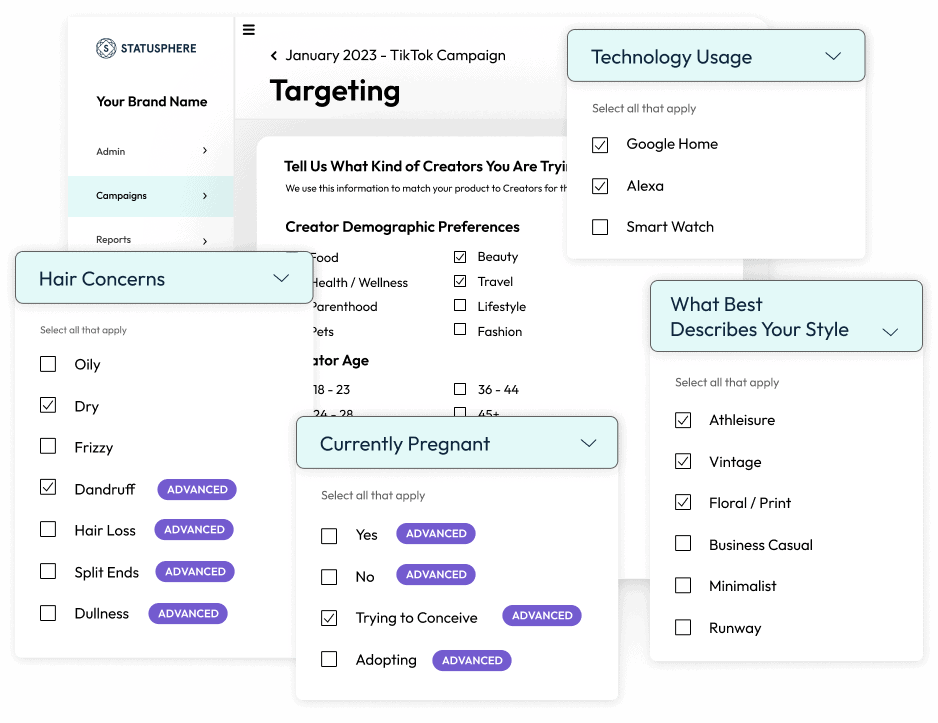
Is your influencer targeting on point?
Finding niche creators is still a top challenge of influencer discovery.
Because targeting influencers using basic demographic data yields generic (or irrelevant!) results.
And so brands should consider taking a more granular approach to influencer segmentation.
That means gathering more data on creators for the best influencer targeting possible. Still, collecting and segmenting that data is a time-sink if you track it manually in an influencer CRM.
Below we break down opportunities to streamline and automate your influencer targeting and segmentation so you can scale your influencer community faster.
Influencer Targeting vs. Influencer Segmentation
For starters, let's clarify the distinction between influencer targeting and segmentation:
Influencer segmentation is the process of organizing creators based on specific criteria.
For example, you may divide your list of creators based on criteria including:
- Follower count (micro-influencers vs. macro-influencers)
- Demographics (age, gender, location)
- Social platforms (TikTok vs. Instagram)
- Products promoted
- Campaigns
- Engagement rate %
How granular you get with influencer segmentation largely depends on your tech stack. For example, you might manually input these notes into an influencer spreadsheet or CRM. Some influencer platforms and reporting tools automatically segment influencers by these parameters.
Influencer targeting is the process of using creators' personal details and data points to find creators who best reflect your target audience.
Both qualitative and quantitative data like the points detailed noted above impact the quality and effectiveness of your influencer targeting. This includes demographics, product preferences, engagement data and more.
Below is an example of what influencer targeting looks like on Statusphere's platform. For reference, our software uses 250+ unique, first-party creator data points to segment influencers.

You can think of influencer targeting as you would social ad targeting. For example, running ads on Instagram or TikTok requires that you specify an audience (or use a lookalike audience) to ensure that you're primarily reaching potential customers.
Apply the same concept to influencer targeting. Instead of lumping your creators into general buckets ("beauty influencers"), consider how you can segment creators with meaningful labels that reflect your target audience ("40+ skincare micro-influencers"). This makes searching for new or past influencers much more efficient next time you run a targeted campaign.
How you target influencers depends on how much data you have, not to mention whether you're using an influencer management platform or CRM to track your creators.
For example, searching for influencers on TikTok or Instagram natively using basic search filters means that your influencer targeting is limited. The same applies to databases or platforms that only allow you to filter creators based on basic demographics or generic buckets.
How to Achieve the Best Influencer Targeting Possible
Your influencer targeting is only as strong as the depth of data you collect and analyze.
This means both your approach to tracking influencer marketing campaigns and the platform you use to manage influencers are under the microscope here.
That said, here's a snapshot of the data needed for effective influencer targeting:
- First-party influencer marketing data. Ensure your data is up-to-date and gathered from reliable sources. First-party data is ideal because it’s accurate and current. Using tools with API access to gather this data is crucial here. This is one of the biggest shortcomings of manually trying to do influencer segmentation and targeting in spreadsheets as information is instantly outdated. Similarly, this is a big reason why influencer databases are faulty and often inaccurate.
- Qualitative influencer data. This includes demographics, product preferences and the types of products that creators want to promote. These data points help you understand the interests and characteristics of the influencers you’re considering for collabs.
- Quantitative influencer data. This includes data related to audience size, engagement rates and other relevant influencer metrics. Aligned with qualitative data, you can align with relevant influencers to reach audiences big and small depending on the scope of your campaign.
- Goals and benchmarks. Consider that the influencers you target will vary depending on your influencer marketing goals. For example, the creators you choose to maximize brand awareness for a product launch may not be the same as creators for a campaign promoting a niche product.
3 Ways to Automate Influencer Targeting and Segmentation to Scale Collabs
Now, let’s look at three ways to improve your influencer targeting and segmentation.
All three of these strategies are fair game but largely depend on whether you're using influencer management software to run your campaigns:
1. Gather the Right Information from Inbound Influencers
First things first: start by collecting detailed info during the onboarding or application process.
For example, you should gather data on creators such as demographics and product preferences by default if you're recruiting and vetting influencers yourself. Some sample questions you could ask on your influencer application could be:
- What is your @handle on [insert social media platform]?
- How many followers do you have on [insert social media platform]?
- Which platforms are you currently active on? (check all that apply)
- What brands in [industry] have you partnered with in the past?
- Do you currently follow [insert your brand name] on [insert social platform]?
- How many times per month do you post about brands on [insert social platform]?
There are plenty of free influencer marketing tools to empower creators to input this information during the intake process. Here's an example from Typeform:

Ideally, this information should be fed into your influencer CRM automatically instead of inputting it yourself. Regardless, having all of the above upfront helps segment creators more effectively with less manual legwork on your part.
2. Implement Influencer Scoring and Segmentation Parameters
Similar to lead scoring, influencer scoring helps you determine who’s a good fit based on objective parameters and behavior. This includes:
- Product preferences
- Demographics (age, location, gender)
- Collaboration experience (measured in # of collabs)
- Follower count
- Engagement rate
- Posting frequency
Below is an example of what automated influencer segmentation and scoring look like for brands that match with creators via Statusphere's platform.
.jpg?width=688&height=495&name=influencer%20segmentation%20example%20(for%20blog).jpg)
Influencer segmentation is crucial for large creator communities as you determine which types of influencers are best for specific promotions. There's a big difference between creators promoting a CPG product to Gen Z women versus a campaign promoting the same product to millennial men.
Objective scoring and segmentation can identify the best matches possible. Keep in mind that scoring is typically done by an algorithm "behind the scenes" but could be done by hand. The caveat to manual scoring is that you open yourself to human error and potential mismatches.
3. Use Influencer Targeting Software to Match with Creators
Brands eager to match with creators at scale rely on dedicated platforms to make it happen.
Again, spreadsheets and manual segmentation are prone to human error. Contrast this with a tool that automatically sources first-party, real-time influencer data in one place.
Using a platform for influencer targeting can help you achieve matches with high volumes of creators (think: 100s or 1000s instantly). Below is a snapshot of how Statusphere's software targets and matches brands with creators at scale using first-party and a vetted network.

This exponentially speeds up and streamlines the process of finding influencers with minimal legwork. This is especially true in the case of micro-influencer campaigns where vetting requires extra attention to detail and sometimes it's difficult to tell a content creator from a non-influencer.
Like we said earlier, you can think of influencer targeting like you would ad targeting. Platforms empower brands to create influencer lookalike audiences that resemble their target audiences with less guesswork.
How to Upgrade Your Influencer Targeting
Automated influencer targeting is huge for the sake of scaling an influencer community.
That's because manual influencer discovery is tedious, time-consuming and inefficient. Sifting through influencer applications yourself or coming through profiles by hand isn't an option if you realistically want to build a thriving influencer community without sacrificing your schedule.
And the more time you free up from your schedule, the more time you can spend on optimizing your campaigns and building meaningful relationships with your influencer community.
And that’s where Statusphere’s influencer marketing software can help.
Again, our platform serves as an all-in-one influencer management tool for brands to build and manage their communities at scale with minimal legwork. We eliminate time-consuming communication and automate the process of getting products into vetted creators’ hands ASAP.
Want to see how our platform works? Get in touch with one of our experts to see how Statusphere's software can help your brand build authentic connections with influencers at scale.
